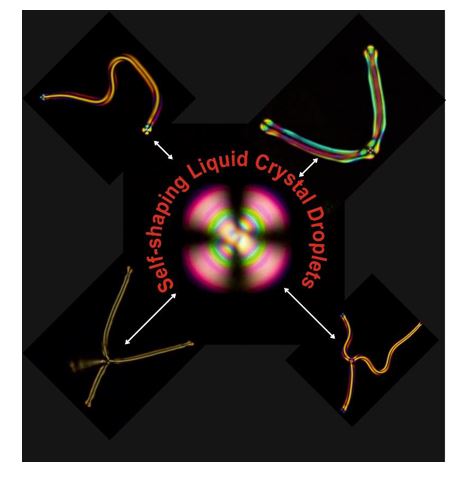Video Article Open Access
Self-shaping Liquid Crystals: The Role of Interfacial Tension
K. Peddireddy1,2, S. Copar3, K. V. Le4, I. Musevic3,5, Ch. Bahr2, V. S. R. Jampani1,5,6*
1Max Planck Institute for dynamics and self-organization, Am Fassberg 17, 37077 Goettingen, Germany.
2University of San Diego, CA, 92110, USA.
3University of Ljubljana, FMF, Jadranska 19, 1000 Ljubljana, Slovenia.
4Tokyo University of Science, 1-3 Kagirazaka, Shinjuku-ku, Tokyo-162-8601, Japan.
5Jozef Stefan Institute, Jamova 39, 1000 Ljubljana, Slovenia.
6University of Luxembourg, Avenue de la Faiencerie, 162a, L-1511, Luxembourg
Vid. Proc. Adv. Mater., Volume 3, Article ID 2210355 (2022)
DOI: 10.5185/vpoam.2022.10355
Publication Date (Web): 23 Nov 2023
Copyright © IAAM
Graphical Abstract

Abstract
Liquid crystals (LCs) are partially ordered oils and top priority material used in information display devices. The constituent molecular structure of an LCs plays a crucial role in the phase formation and attaining an orientational and positional order, thus carrying bulk elasticity. LCs also attain a spherical shape when suspended in an immiscible medium like any other isotropic liquids dictated by the interfacial tension. Many reports show the possibility of transforming the liquid droplet into various non-spherical curved structures in recent years [1-4]. This talk will present our recent work [5] on transforming LC droplets into linear and branched structures. Importantly, all these structures show fully reversible shape transformation at a fixed volume. In detail, we have used a key strategy of achieving dynamic interfacial tension using two surfactants—one is dispersed in LC medium, and the other is in the continuous aqueous medium—for fully reversible shape transformation in all nematic LCs. The tuning of the elastic constants with the temperature drives the LC droplet into controllable fibre structures with branches and back reversibly, as shown above in the graphical abstract. The dynamic interfacial tension coupled to the bulk LC phase, for example, nematic to SmA LC phase transition drives the fibre structures into monodispersed micro-droplets with a tunable diameter dictated by the cooling rate. The extension of the self-shaping phenomenon in the SmC phase opens the route to generate helical fibres with an equal probability of right and left-handed helices, and the SmC* phase shows life-like self-shaping LC shell structures analogous to the bio-membranes in living systems.
Keywords
liquid crystals, self-shaping, interfacial tension, emulsions, surfactants.
Acknowledgement
The authors acknowledge research fundings received from Fonds National de la Recherche (Grant ID C17/MS/11703329/trendsetter), ARRS Grant No. N1-0175 (VSRJ), P1-0099 (IM) and J1-9149 (SC), EC Marie Curie Initial Training Networks Project Hierarchy—PITN-CA-2008-215851 (CB & KP), Horizon 2020 research and innovation programme (Grant Agreement No. 884928-LOGOS) (IM), Air Force Office of Scientific Research (AFOSR-FA9550-171-0249) (KP), NSF (NSF-CBET-1603925) (KP), and Japan Society for the Promotion Science KAKENHI (Grant No.JP18K14094) (KVL).
References
- Denkov N., Tcholakova S., Lesov I., Cholakova D., Smoukov S.K.; Nature, 2015, 528(7582), 392.
- Guttman S., Sapir Z., Schultz M., et al.; Proc Natl Acad Sci., 2016, 113(3), 493-496.
- Wei W.S., Xia Y., Ettinger S., Yang S., Yodh A.G.; Nature, 2019, 576(7787), 433-436.
- Pratibha R., Madhusudana N.V.; J. Phys. II, 1992, 2(3), 383-400.
- Peddireddy K., Čopar S., Le K.V., Muševič I., Bahr C., Jampani VSR. Proc Natl Acad Sci USA, 2021, 118(14),17.
Biography
Dr Jampani received PhD in physics in 2013 from the University of Ljubljana, Slovenia. Later he moved on to several post-doc positions at Max-Plank Institute for Dynamics and Self-organization, Germany, RIKEN Center for Emergent Matter Science, Japan, and the University of Luxembourg. Since 2017, he has been carrying out liquid crystal research as an independent PI. His interests are liquid crystals, colloids, liquid crystal elastomers, and liquid crystal photonics.
Video Proceedings of Advanced Materials

Upcoming Congress



